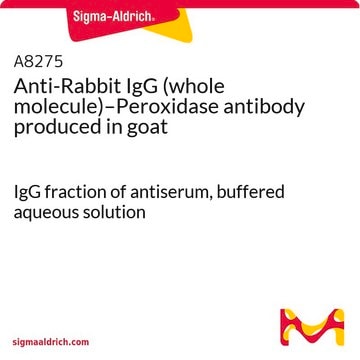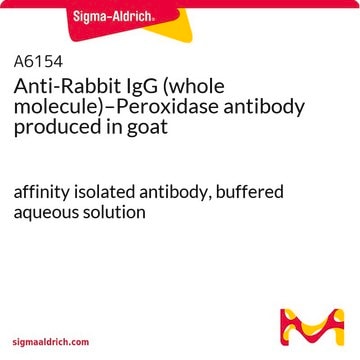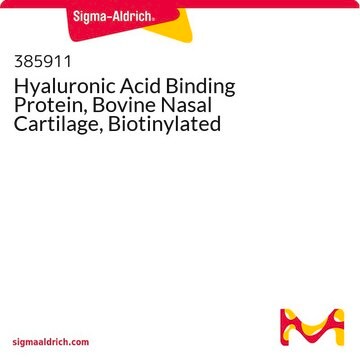401515
Rabbit Anti-Goat IgG, H & L Chain Specific Peroxidase Conjugate
liquid, Calbiochem®
Sign Into View Organizational & Contract Pricing
All Photos(1)
About This Item
UNSPSC Code:
12352203
NACRES:
NA.46
Recommended Products
biological source
rabbit
Quality Level
antibody form
affinity isolated antibody
antibody product type
secondary antibodies
clone
polyclonal
form
liquid
contains
0.02% Thimerosal as preservative
manufacturer/tradename
Calbiochem®
storage condition
do not freeze
isotype
IgG
shipped in
wet ice
storage temp.
2-8°C
target post-translational modification
unmodified
General description
Immunoaffinity purified rabbit polyclonal antibody conjugated to horseradish peroxidase. Recognizes goat IgG, heavy and light chains.
This Rabbit Anti-Goat IgG, H & L Chain Specific Peroxidase Conjugate is validated for use in Direct Immunoassay for the detection of Goat IgG, H & L Chain Specific.
Application
Direct Immunoassay (1:10,000)
Packaging
Please refer to vial label for lot-specific concentration.
Warning
Toxicity: Standard Handling (A)
Physical form
In 10 mM PBS, 0.5 mM EDTA, 10% mannose, 2% sucrose and 1% BSA, pH 7.6.
Other Notes
o-phenylenediamine, 1 mg/ml in citrate buffer, pH 4.5, 0.1% urea peroxide at 25°C, was used as the substrate for testing immunoenzyme reactivity. Monospecific for goat immunoglobulin G, heavy and light chain as determined by immunoelectrophoresis against normal goat serum. Variables associated with assay conditions will dictate the proper working dilution.
Legal Information
CALBIOCHEM is a registered trademark of Merck KGaA, Darmstadt, Germany
Disclaimer
To comply with ban of sale of mercury-added products required by The Interstate Mercury Education and Reduction Clearinghouse (IMERC), this product is prohibited to be sold in the following US states: Rhode Island and Connecticut.
Not finding the right product?
Try our Product Selector Tool.
Storage Class Code
12 - Non Combustible Liquids
WGK
WGK 2
Flash Point(F)
Not applicable
Flash Point(C)
Not applicable
Certificates of Analysis (COA)
Search for Certificates of Analysis (COA) by entering the products Lot/Batch Number. Lot and Batch Numbers can be found on a product’s label following the words ‘Lot’ or ‘Batch’.
Already Own This Product?
Find documentation for the products that you have recently purchased in the Document Library.
Astrid Agorio et al.
Proceedings of the National Academy of Sciences of the United States of America, 114(16), E3354-E3363 (2017-04-05)
"Too much of a good thing" perfectly describes the dilemma that living organisms face with metals. The tight control of metal homeostasis in cells depends on the trafficking of metal transporters between membranes of different compartments. However, the mechanisms regulating
Esther A Guzmán et al.
Investigational new drugs, 29(5), 777-785 (2010-03-31)
Pancreatic cancer is the fourth leading cause of cancer death in the United States, and new drugs to treat the disease are needed. Pancreatic cancer cells are highly metastatic and exhibit resistance to apoptosis. Small molecules that can restore sensitivity
Lorena Carvelli et al.
PloS one, 16(4), e0250454-e0250454 (2021-04-30)
In the epididymis, lysosomal proteins of the epithelial cells are normally targeted from the Golgi apparatus to lysosomes for degradation, although their secretion into the epididymal lumen has been documented and associated with sperm maturation. In this study, cathepsin D
Bishara J Freij et al.
Frontiers in immunology, 11, 624415-624415 (2021-03-09)
STAT2 is a transcription factor that plays an essential role in antiviral immunity by mediating the activity of type I and III interferons (IFN-I and IFN-III). It also has a recently established function in the negative regulation of IFN-I signaling.
Lorena Carvelli et al.
PloS one, 18(9), e0292157-e0292157 (2023-09-27)
Heparan sulfate (HS), an abundant component of the apical cell surface and basement membrane, belongs to the glycosaminoglycan family of carbohydrates covalently linked to proteins called heparan sulfate proteoglycans. After endocytosis, HS is degraded in the lysosome by several enzymes
Our team of scientists has experience in all areas of research including Life Science, Material Science, Chemical Synthesis, Chromatography, Analytical and many others.
Contact Technical Service








